Zhimeng Jiang
A Closer Look on Memorization in Tabular Diffusion Model: A Data-Centric Perspective
May 28, 2025Abstract:Diffusion models have shown strong performance in generating high-quality tabular data, but they carry privacy risks by reproducing exact training samples. While prior work focuses on dataset-level augmentation to reduce memorization, little is known about which individual samples contribute most. We present the first data-centric study of memorization dynamics in tabular diffusion models. We quantify memorization for each real sample based on how many generated samples are flagged as replicas, using a relative distance ratio. Our empirical analysis reveals a heavy-tailed distribution of memorization counts: a small subset of samples contributes disproportionately to leakage, confirmed via sample-removal experiments. To understand this, we divide real samples into top- and non-top-memorized groups and analyze their training-time behaviors. We track when each sample is first memorized and monitor per-epoch memorization intensity (AUC). Memorized samples are memorized slightly earlier and show stronger signals in early training. Based on these insights, we propose DynamicCut, a two-stage, model-agnostic mitigation method: (a) rank samples by epoch-wise intensity, (b) prune a tunable top fraction, and (c) retrain on the filtered dataset. Across multiple tabular datasets and models, DynamicCut reduces memorization with minimal impact on data diversity and downstream performance. It also complements augmentation-based defenses. Furthermore, DynamicCut enables cross-model transferability: high-ranked samples identified from one model (e.g., a diffusion model) are also effective for reducing memorization when removed from others, such as GANs and VAEs.
Towards Efficient Large Scale Spatial-Temporal Time Series Forecasting via Improved Inverted Transformers
Mar 13, 2025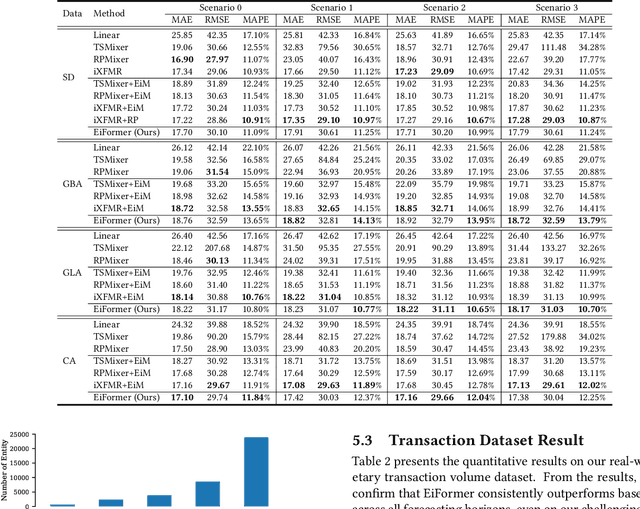

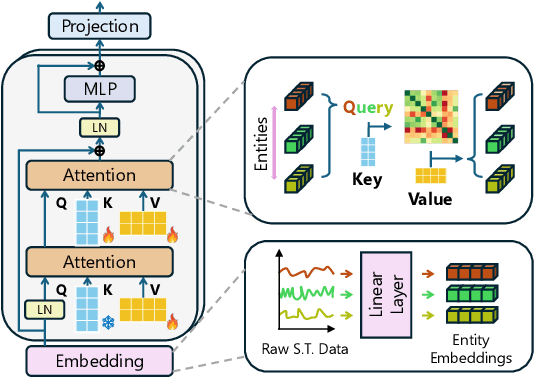
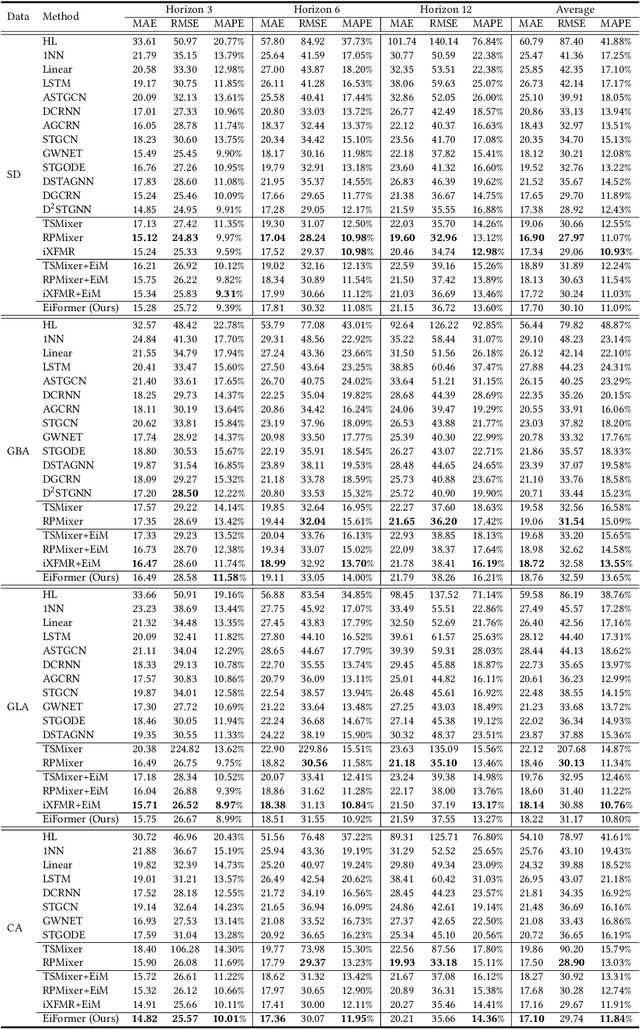
Abstract:Time series forecasting at scale presents significant challenges for modern prediction systems, particularly when dealing with large sets of synchronized series, such as in a global payment network. In such systems, three key challenges must be overcome for accurate and scalable predictions: 1) emergence of new entities, 2) disappearance of existing entities, and 3) the large number of entities present in the data. The recently proposed Inverted Transformer (iTransformer) architecture has shown promising results by effectively handling variable entities. However, its practical application in large-scale settings is limited by quadratic time and space complexity ($O(N^2)$) with respect to the number of entities $N$. In this paper, we introduce EiFormer, an improved inverted transformer architecture that maintains the adaptive capabilities of iTransformer while reducing computational complexity to linear scale ($O(N)$). Our key innovation lies in restructuring the attention mechanism to eliminate redundant computations without sacrificing model expressiveness. Additionally, we incorporate a random projection mechanism that not only enhances efficiency but also improves prediction accuracy through better feature representation. Extensive experiments on the public LargeST benchmark dataset and a proprietary large-scale time series dataset demonstrate that EiFormer significantly outperforms existing methods in both computational efficiency and forecasting accuracy. Our approach enables practical deployment of transformer-based forecasting in industrial applications where handling time series at scale is essential.
You Only Debias Once: Towards Flexible Accuracy-Fairness Trade-offs at Inference Time
Mar 10, 2025Abstract:Deep neural networks are prone to various bias issues, jeopardizing their applications for high-stake decision-making. Existing fairness methods typically offer a fixed accuracy-fairness trade-off, since the weight of the well-trained model is a fixed point (fairness-optimum) in the weight space. Nevertheless, more flexible accuracy-fairness trade-offs at inference time are practically desired since: 1) stakes of the same downstream task can vary for different individuals, and 2) different regions have diverse laws or regularization for fairness. If using the previous fairness methods, we have to train multiple models, each offering a specific level of accuracy-fairness trade-off. This is often computationally expensive, time-consuming, and difficult to deploy, making it less practical for real-world applications. To address this problem, we propose You Only Debias Once (YODO) to achieve in-situ flexible accuracy-fairness trade-offs at inference time, using a single model that trained only once. Instead of pursuing one individual fixed point (fairness-optimum) in the weight space, we aim to find a "line" in the weight space that connects the accuracy-optimum and fairness-optimum points using a single model. Points (models) on this line implement varying levels of accuracy-fairness trade-offs. At inference time, by manually selecting the specific position of the learned "line", our proposed method can achieve arbitrary accuracy-fairness trade-offs for different end-users and scenarios. Experimental results on tabular and image datasets show that YODO achieves flexible trade-offs between model accuracy and fairness, at ultra-low overheads. For example, if we need $100$ levels of trade-off on the \acse dataset, YODO takes $3.53$ seconds while training $100$ fixed models consumes $425$ seconds. The code is available at https://github.com/ahxt/yodo.
A Compact Model for Large-Scale Time Series Forecasting
Feb 28, 2025



Abstract:Spatio-temporal data, which commonly arise in real-world applications such as traffic monitoring, financial transactions, and ride-share demands, represent a special category of multivariate time series. They exhibit two distinct characteristics: high dimensionality and commensurability across spatial locations. These attributes call for computationally efficient modeling approaches and facilitate the use of univariate forecasting models in a channel-independent fashion. SparseTSF, a recently introduced competitive univariate forecasting model, harnesses periodicity to achieve compactness by concentrating on cross-period dynamics, thereby extending the Pareto frontier with respect to model size and predictive performance. Nonetheless, it underperforms on spatio-temporal data due to an inadequate capture of intra-period temporal dependencies. To address this shortcoming, we propose UltraSTF, which integrates a cross-period forecasting module with an ultra-compact shape bank component. Our model effectively detects recurring patterns in time series through the attention mechanism of the shape bank component, thereby strengthening its ability to learn intra-period dynamics. UltraSTF achieves state-of-the-art performance on the LargeST benchmark while employing fewer than 0.2% of the parameters required by the second-best approaches, thus further extending the Pareto frontier of existing methods.
MAIN-RAG: Multi-Agent Filtering Retrieval-Augmented Generation
Dec 31, 2024



Abstract:Large Language Models (LLMs) are becoming essential tools for various natural language processing tasks but often suffer from generating outdated or incorrect information. Retrieval-Augmented Generation (RAG) addresses this issue by incorporating external, real-time information retrieval to ground LLM responses. However, the existing RAG systems frequently struggle with the quality of retrieval documents, as irrelevant or noisy documents degrade performance, increase computational overhead, and undermine response reliability. To tackle this problem, we propose Multi-Agent Filtering Retrieval-Augmented Generation (MAIN-RAG), a training-free RAG framework that leverages multiple LLM agents to collaboratively filter and score retrieved documents. Specifically, MAIN-RAG introduces an adaptive filtering mechanism that dynamically adjusts the relevance filtering threshold based on score distributions, effectively minimizing noise while maintaining high recall of relevant documents. The proposed approach leverages inter-agent consensus to ensure robust document selection without requiring additional training data or fine-tuning. Experimental results across four QA benchmarks demonstrate that MAIN-RAG consistently outperforms traditional RAG approaches, achieving a 2-11% improvement in answer accuracy while reducing the number of irrelevant retrieved documents. Quantitative analysis further reveals that our approach achieves superior response consistency and answer accuracy over baseline methods, offering a competitive and practical alternative to training-based solutions.
Understanding and Mitigating Memorization in Diffusion Models for Tabular Data
Dec 15, 2024Abstract:Tabular data generation has attracted significant research interest in recent years, with the tabular diffusion models greatly improving the quality of synthetic data. However, while memorization, where models inadvertently replicate exact or near-identical training data, has been thoroughly investigated in image and text generation, its effects on tabular data remain largely unexplored. In this paper, we conduct the first comprehensive investigation of memorization phenomena in diffusion models for tabular data. Our empirical analysis reveals that memorization appears in tabular diffusion models and increases with larger training epochs. We further examine the influence of factors such as dataset sizes, feature dimensions, and different diffusion models on memorization. Additionally, we provide a theoretical explanation for why memorization occurs in tabular diffusion models. To address this issue, we propose TabCutMix, a simple yet effective data augmentation technique that exchanges randomly selected feature segments between random same-class training sample pairs. Building upon this, we introduce TabCutMixPlus, an enhanced method that clusters features based on feature correlations and ensures that features within the same cluster are exchanged together during augmentation. This clustering mechanism mitigates out-of-distribution (OOD) generation issues by maintaining feature coherence. Experimental results across various datasets and diffusion models demonstrate that TabCutMix effectively mitigates memorization while maintaining high-quality data generation.
Gradient Rewiring for Editable Graph Neural Network Training
Oct 21, 2024



Abstract:Deep neural networks are ubiquitously adopted in many applications, such as computer vision, natural language processing, and graph analytics. However, well-trained neural networks can make prediction errors after deployment as the world changes. \textit{Model editing} involves updating the base model to correct prediction errors with less accessible training data and computational resources. Despite recent advances in model editors in computer vision and natural language processing, editable training in graph neural networks (GNNs) is rarely explored. The challenge with editable GNN training lies in the inherent information aggregation across neighbors, which can lead model editors to affect the predictions of other nodes unintentionally. In this paper, we first observe the gradient of cross-entropy loss for the target node and training nodes with significant inconsistency, which indicates that directly fine-tuning the base model using the loss on the target node deteriorates the performance on training nodes. Motivated by the gradient inconsistency observation, we propose a simple yet effective \underline{G}radient \underline{R}ewiring method for \underline{E}ditable graph neural network training, named \textbf{GRE}. Specifically, we first store the anchor gradient of the loss on training nodes to preserve the locality. Subsequently, we rewire the gradient of the loss on the target node to preserve performance on the training node using anchor gradient. Experiments demonstrate the effectiveness of GRE on various model architectures and graph datasets in terms of multiple editing situations. The source code is available at \url{https://github.com/zhimengj0326/Gradient_rewiring_editing}
Better Late Than Never: Formulating and Benchmarking Recommendation Editing
Jun 06, 2024Abstract:Recommendation systems play a pivotal role in suggesting items to users based on their preferences. However, in online platforms, these systems inevitably offer unsuitable recommendations due to limited model capacity, poor data quality, or evolving user interests. Enhancing user experience necessitates efficiently rectify such unsuitable recommendation behaviors. This paper introduces a novel and significant task termed recommendation editing, which focuses on modifying known and unsuitable recommendation behaviors. Specifically, this task aims to adjust the recommendation model to eliminate known unsuitable items without accessing training data or retraining the model. We formally define the problem of recommendation editing with three primary objectives: strict rectification, collaborative rectification, and concentrated rectification. Three evaluation metrics are developed to quantitatively assess the achievement of each objective. We present a straightforward yet effective benchmark for recommendation editing using novel Editing Bayesian Personalized Ranking Loss. To demonstrate the effectiveness of the proposed method, we establish a comprehensive benchmark that incorporates various methods from related fields. Codebase is available at https://github.com/cycl2018/Recommendation-Editing.
LLM Maybe LongLM: Self-Extend LLM Context Window Without Tuning
Jan 02, 2024Abstract:This work elicits LLMs' inherent ability to handle long contexts without fine-tuning. The limited length of the training sequence during training may limit the application of Large Language Models (LLMs) on long input sequences for inference. In this work, we argue that existing LLMs themselves have inherent capabilities for handling long contexts. Based on this argument, we suggest extending LLMs' context window by themselves to fully utilize the inherent ability.We propose Self-Extend to stimulate LLMs' long context handling potential. The basic idea is to construct bi-level attention information: the group level and the neighbor level. The two levels are computed by the original model's self-attention, which means the proposed does not require any training. With only four lines of code modification, the proposed method can effortlessly extend existing LLMs' context window without any fine-tuning. We conduct comprehensive experiments and the results show that the proposed method can effectively extend existing LLMs' context window's length.
Towards Mitigating Dimensional Collapse of Representations in Collaborative Filtering
Dec 29, 2023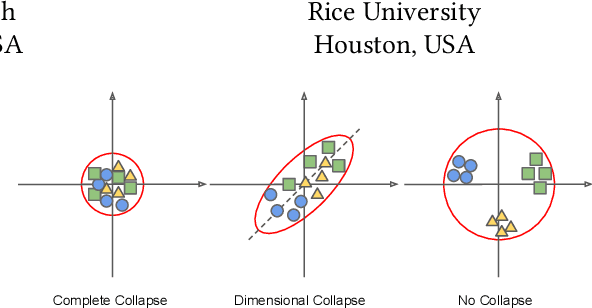
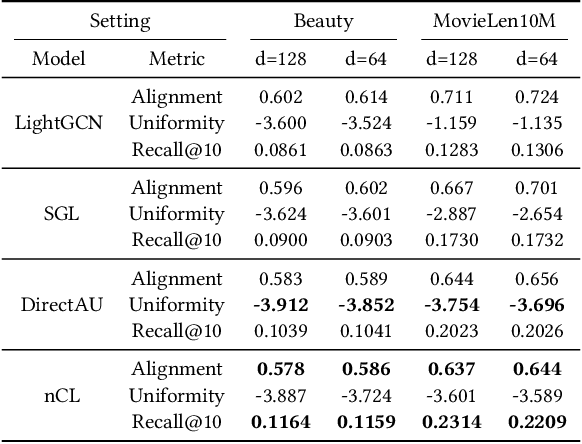
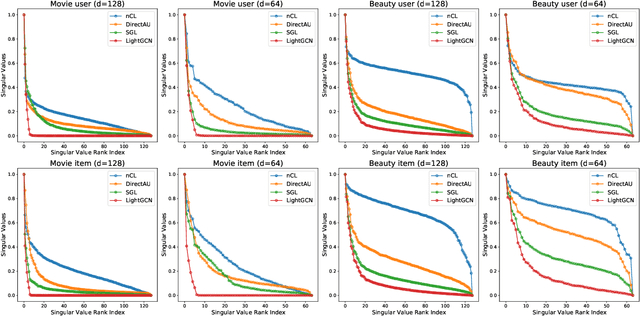
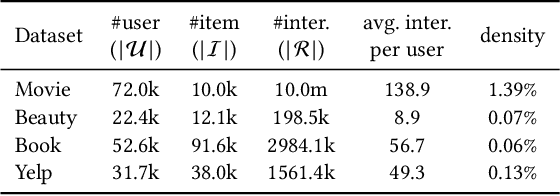
Abstract:Contrastive Learning (CL) has shown promising performance in collaborative filtering. The key idea is to generate augmentation-invariant embeddings by maximizing the Mutual Information between different augmented views of the same instance. However, we empirically observe that existing CL models suffer from the \textsl{dimensional collapse} issue, where user/item embeddings only span a low-dimension subspace of the entire feature space. This suppresses other dimensional information and weakens the distinguishability of embeddings. Here we propose a non-contrastive learning objective, named nCL, which explicitly mitigates dimensional collapse of representations in collaborative filtering. Our nCL aims to achieve geometric properties of \textsl{Alignment} and \textsl{Compactness} on the embedding space. In particular, the alignment tries to push together representations of positive-related user-item pairs, while compactness tends to find the optimal coding length of user/item embeddings, subject to a given distortion. More importantly, our nCL does not require data augmentation nor negative sampling during training, making it scalable to large datasets. Experimental results demonstrate the superiority of our nCL.
 Add to Chrome
Add to Chrome Add to Firefox
Add to Firefox Add to Edge
Add to Edge